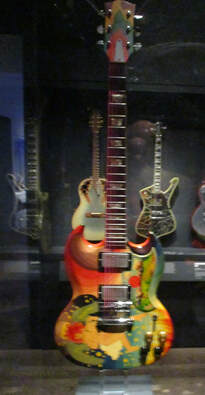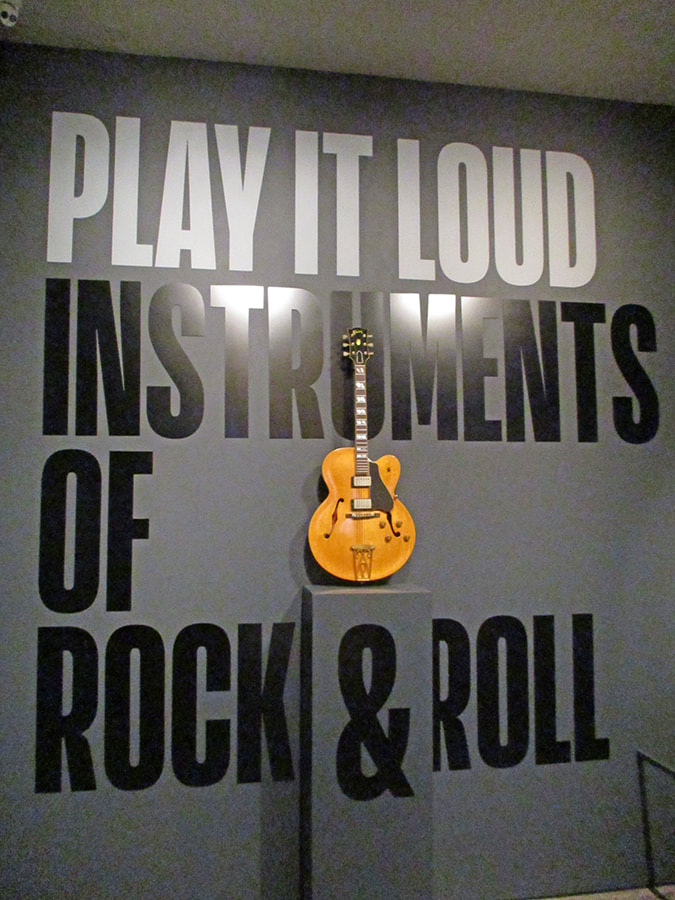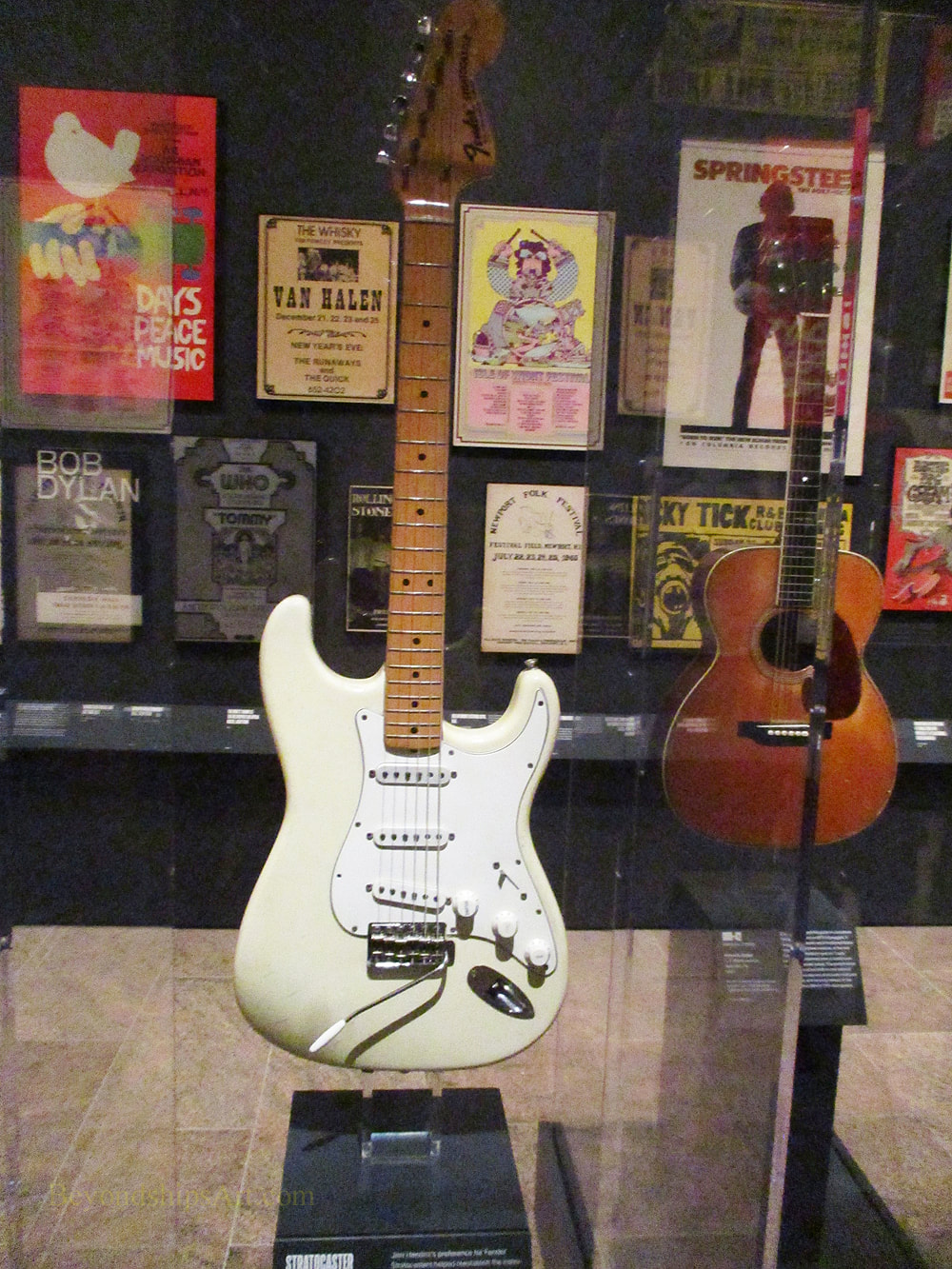"Play It Loud: Instruments of Rock and Roll" Eric Clapton's SG. Eric Clapton's SG.
“Play It Loud: Instruments of Rock and Roll” at the Metropolitan Museum in New York City is the first exhibition by a major art museum exploring the instruments used in rock and roll. It was organized by the Met in collaboration with the Rock and Roll Hall of Fame.
Musical instruments have long been recognized as works of art. Indeed, the Met has an entire department devoted to musical instruments. Inasmuch as rock and roll has transcended entertainment to become a cultural force, it is only appropriate that the musical instruments used in creating rock and roll be given serious study and exhibition. Some 130 instruments are included in this exhibition. Rather than approach the subject from the standpoint of who designed or made these instruments, the focus is on the role these instruments played in creating landmark music. For example, near the entrance to the exhibition is a large display cabinet including a set of Ludwig drums, a Rickenbacker guitar and a Hofner guitar. The three companies that made these instruments were important 20th century musical instrument manufacturers. However, what makes these instruments important and what attracts people to this display like a magnet is that these instruments belonged to the Beatles (Ringo Starr, John Lennon and George Harrison specifically). In the same gallery are instruments owned and/or played by Elvis, Jerry Lee Lewis, Bo Diddley and Chuck Berry to name a few of the artists. In the next gallery are instruments played by the Guitar Gods. Beginning in the late 1960s, the lead guitarists of various bands equaled and sometimes eclipsed the vocalists in significance. Here we find Fender Stratocasters played by Jimi Hendrix and Eric Clapton. Jimmy Page's Gibson Les Paul, Duane Allman's Gibson SG, and a custom made guitar played by Jerry Garcia. To fans these instruments are familiar from concerts and record album covers. Some of the instruments have been elaborately decorated. The Gibson SG used by Eric Clapton when he was with Cream has a psychedelic finish reflecting that era of the “counterculture.” Similarly, Keith Richard's Les Paul was decorated in acrylics by Mr. Richards with a multi-colored drawing of a moonscape. Other instruments, such as Eric Clapton's “Blackie” show their role as workhorses as even the manufacturer's finish has worn off in places. The next gallery recognizes that rock and roll is not just guitars. Here, we have the instruments played by the rythym sections of the bands – drums and bass as well as organs, pianos, saxophones, and more exotic instruments such as sitars and synthesizers. As you read the signs beside each display you find that these are not generic examples but rather instruments with a history. For example, the Hammond organ with the knife sticking into the keyboard was played by Keith Emerson of Emerson, Lake and Palmer. The nearby mellatron was played by Brian Jones of the Rolling Stones on some of that group's most important albums. The final section of the exhibition looks at how instruments were used to create an image. There is the remains of the Fender Stratocaster that Jimi Hendrix burnt on stage at the Monterrey Pop Festival and a sculpture made out of instruments destroyed during a performance by The Who. A less violent display is an electric piano with a modernistic shape used by Lady Gaga in a television performance. In addition to the displays of instruments, the exhibition includes large screens with videos of people such as Keith Richards and Jimmy Page talking about and playing their instruments. There is also a giant screen showing clips of performances by various artists from the beginnings of rock and roll to recent times. Somewhat eclipsed by the instruments are approximately 40 posters for rock and roll concerts. This is unfortunate because some of these posters such as those done for the Fillmore in San Francisco were not block lettering on a plain background but rather were artistic creations, drawing on art nouveau and psychedelic art. I found this to be a thoroughly interesting and enjoyable exhibition. It takes a different approach to exploring this cultural force and era. I worked in the music industry in the early 1970s and saw many rock concerts. Yet, I learned things from this exhibition. The only disturbing thing I found about this exhibition is that I can remember when several of these “museum pieces” were in active use. But it all goes to show that the old song was right: “Rock and roll is here to stay.” |
Above: Instruments played by The Beatles.
Above: Jimi Hendrix's Fender Stratocaster. In the background is an acoustic guitar played by Eric Clapton.
Below: Jimmy Page's "Number 1", a Gibson Les Paul. |
Art review - Metropolitan Museum of Art - “Play It Loud”



